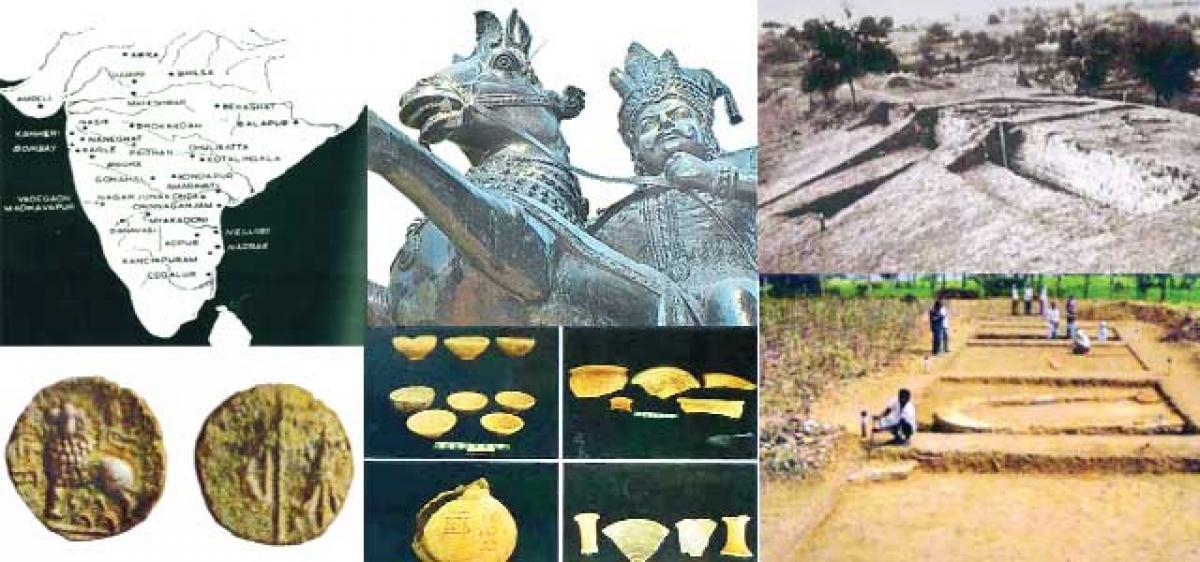Just In

Historians of North India have always stated that there are 16 great Janapadas (Shodasa Maha Janapadas) in North India during the 6th century BC. And they ignored the Janapadas of South India.
The excavations at Kotalingala, Karimnagar district reveal that it was ruled by Satavahana dynasty and was indeed the very first capital city of not only Telangana, but also for the entire Telugu speaking areas
Historians of North India have always stated that there are 16 great Janapadas (Shodasa Maha Janapadas) in North India during the 6th century BC. And they ignored the Janapadas of South India.
Archaeological excavations conducted at Amaravati- Dhanyakataka in Coastal Andhra region and Kotalingala in Telangana region revealed that there were two Janapadas contemporary to the 16 Janapadas of the Northern India.
The digs at Amaravati laid bare silver punch-marked (uninscribed) coins, Northern Black Polished Ware (NBP Ware) in the lower levels of the early historic phase, which clearly attests the fact that Dhanyakataka served as an independently ruling Republic.
On the other hand, the excavations carried out at Kotalingala, an early historic site located on the left bank of the river Godavari in Karimnagar district of the present day Telangana State also yielded evidences proving beyond doubt that Kotalingala served as the very first capital city of not only Telangana, but also for the entire Telugu speaking areas including the present State of Andhra Pradesh, which made the archaeologists and historians to raise their eyebrows.
It was Dr NS Rama Chandra Murthy, the then Assistant Director, Department of Archaeology and Museums, Karimnagar region under the directions of Dr VV Krishna Shastry, the then Director of the Department, took up excavations at Kotalingala in 1978 and unearthed hitherto not known historical evidence dating back to the pre-Satavahana times.
Dr Rama Chandra Murthy uncovered a huge mud and brick fortification with bastions on the corners, a grandiose gateway at the entrance, palace complex, residential structures and remains of Buddhist stupas, chaityas and viharas.
Other interesting finds include punch marked coins, Northern Black Polished Ware, Red Ware, Black and Red Ware beads and bangles made of clay, semi-precious stones, ivory and conch (shell), iron implements both agricultural and domestic use, and a few Brahmi label inscriptions from various layers of the strata.
These artefacts, antiquities and structures offered dates ranging in between the 5th century BC to the 2nd century BC representing the early Janapada, the Mauryan, pre-Satavahana (local kings) and Satavahana dynasties.
Among the cultural material, it was the coins that attracted the epigraphists and numismaticians, who did considerable research and disclosed the antiquity of Kotalingala on par with the early Magadha region.
The coins found at Kotilingala categorised as punch-marked coins, uninscribed coins and inscribed coins are studied by Dr PV Parabrahma Sastry, Dr D Raja Reddy and P Satya Narayana Reddy. The punch-marked coins issued in silver and copper struck with some symbols are datable to the 4th- 5th centuries BC according to the scholars.
The second category of coins issued in copper, potin and lead bear some symbols but do not contain any script or legends or names of the kings. The third category of coins issued in lead, copper, potin and brass have some symbols and names of the pre-Satavahana kings that ruled from Kotalingala.
The pre-Satavahana kings, Gobadha, Narana, Kamvaya and Samagopa issued their coins with legends in Brahmi script reading Rano Gobadhasa, Siri Naranasa, Kamvaya Sirisa and Rano Sama Gopasa in 3rd century BC characters.
It is interesting to note that the symbols of Bodhi tree and Triratna on the coins of Samagopa reveal that these pre-Satavahana kings were followers of Buddhism. And Buddhism was a popular religion of the Telangana.
Kotalingala site also yielded inscribed coins of the Satavahanas, a major south Indian dynasty, whose origin is traced from Kotalingala in Telangana state. The region with copper, brass and potin coins of Chimuka, the founder of the Satavahana dynasty bear a legend of Rano Siri Chimuka, followed by the coins of Satakarni-I with a legend of Rano Siri Satakanisa, Satakarni-II with the same legend and Vasisthiputra Pulumavi son of Gautamiputra Satakarni with a legend of Rano Siri Pulumavisa.
The above evidences clearly prove that Kotalingala served as a seat of Assaka Janapada (5th century BC) and continued to be the capital city of the pre-Satavahana kings (3rd century BC) and the Satavahanas (1st century BC). It is further attested by the recovery of the coins from the same site belonging to the sub-ordinate chiefs, who served both the pre-Satavahana and Satavahana kings.
They include coins of Maha Talavara and Maha Senapati and the copper coins of Sebaka with legends.
Basing on the authentic source of information i.e. finding the coins from the lower to upper levels, the archaeologists confirmed that Kotalingala served as not only the first capital but also as the original home of the Satavahanas, who moved to Paithan in Maharashtra during the Satakarni-I rule and to Dhanyakataka-Amaravati via Kondapur during the times of Gautamiputra Satakarni, the mighty emperor, who bore the title ‘Whose Horses Drank the Waters of the Three Seas’ and extended upto Gujarat and Rajasthan.
By: Dr E Siva Nagi Reddy
The writer is Chief Executive Officer of The Cultural Centre of Vijayawada and Amaravati.

© 2024 Hyderabad Media House Limited/The Hans India. All rights reserved. Powered by hocalwire.com







